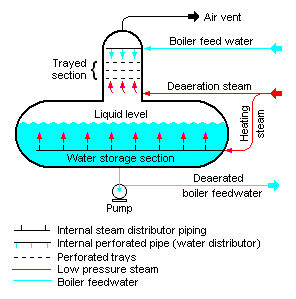A deaerator’s one job is to strip dissolved oxygen and carbon dioxide out of boiler feedwater. When it falls out of tune, oxygen pitting, tube failure, and sudden downtime follow—often in months, not years. Regular deaerator maintenance can keep water below 7 ppb (0.005 cc/L), as recommended by ASME PTC‑123.
How a Deaerator Works
Spray‑ and tray‑type deaerators blend makeup water with a burst of flash steam. The sudden temperature rise, along with agitation drives off the gases, which leave through the vent line. A small change in water level, steam pressure, or vent rate can double residual oxygen, so keeping an eye on your system is critical.
Deaerator Maintenance Tasks
Below is a streamlined routine that covers what operators should check every day, what the water‑treatment team should handle once a month, and what plant staff or an outside contractor should tackle during the annual outage. The wording is plain‑English—no saturation charts, no “motive‑steam” jargon—just the steps that keep oxygen out of your feedwater and corrosion out of your boiler.
Daily Deaerator Maintenance Tasks (2‑Minute Check)
- Storage-Water Temperature vs. Steam Pressure Glance at the thermometer on the storage tank and the steam-inlet gauge.Use this quick rule of thumb:
- 5 psi steam ≈ 230 °F
- 10 psi ≈ 240 °F
- 15 psi ≈ 250 °F
The thermometer should be within 2–3 °F of the expected temperature. If the water is 5 °F or more cooler, a spray nozzle may be clogged or a tray deck may be fouled.
- Vent Plume & Water Level A thin, steady wisp of white vapor means gases are being vented properly. No plume could mean gas isn’t escaping, while a roaring plume may indicate steam waste. The water level should remain steady on the gauge glass. If it swings wildly, check the level control system.
- Visual Leaks & Gauges Inspect welds, valves, and pressure/temperature gauges for signs of leaks, cracks, or broken glass.If you notice an oil sheen on the water surface, plan to skim it off through the overflow line during the next low-load period.
Weekly & Monthly Deaerator Maintenance Tasks
-
-
- Blowdown Water Column — Periodically If your deaerator includes an external water column (for level indication), open the drain valve periodically to clear sediment and ensure the column reads accurately. This is similar to boiler sight glass maintenance and helps prevent false level readings.
- Dissolved-Oxygen Test — Monthly Draw a hot feedwater sample at the deaerator outlet and measure the dissolved oxygen content.
- ≤ 10 ppb without scavenger
- ≈ 0 ppb with scavenger present
If readings climb, check these in order: steam pressure, water temperature, spray nozzles, trays, and venting performance.
- Chemical Feed & Sulfite Trend — Monthly Review the oxygen scavenger pump setting and log your sulfite residuals. A sudden spike or drop can indicate a malfunctioning spray valve or a tray that’s out of position.
- Valve Exercise — Monthly Cycle all isolation and vent valves to keep them from seizing between outages. It only takes a minute and prevents major headaches during inspections or emergencies.
-
Annual Deaerator Maintenance Tasks

Tray Type DA
-
-
-
At a NACE 1986 conference, the following intervals were suggested… After a deaerator is first put into service, it should be inspected within one to two years. After that, the following frequency of inspections was suggested at the NACE 1986 conference:
-
- Repaired cracks, 1 year or less
- Nonrepaired cracks, 1 – 2 years
- No cracks/no repairs, 3 – 5 years
- However, inspection frequencies should ultimatly be determined based on factors such as service conditions, corrosion rates, and jurisdictional requirements.
-
- Open the Vessel – Pull manways, trays, and spray headers to allow full internal access for inspection and cleaning.
- Inspect Welds and Shell – Visually inspect all joints and welds. Use ultrasonic thickness testing on any areas that appear pitted or corroded, and flag wall loss greater than 15% for repair planning.
- Clean the Vent Condenser – Brush or pressure-wash condenser tubes to restore heat transfer efficiency and maintain proper stack temperature.
- Calibrate All Instruments – Bench-test and re-tag pressure gauges, temperature sensors, level controls, and any installed dissolved-oxygen analyzers.
- Run a Chemical-Off Performance Test – Shut off the oxygen scavenger and operate the deaerator at load. Sample the outlet water to confirm it still delivers ≤10 ppb without chemical feed, as expected from a properly functioning unit..
- Document Everything – Log all inspection findings, UT measurements, and calibration records. NBIC Part 2 and most insurers require these records for compliance.
-
-
Common Deaerator Problems & Fixes
For a deeper dive on common problems, see our Deaerator Problems article.
Compliance & Documentation

Spray Type DA
ASME PTC‑123 sets residual O₂ and TTD performance tests. Be sure to keep calibration certificates for all instruments (O₂ meter, pressure gauge, UT) on file for auditors.
Frequently Asked Questions
Q: Do I still need chemical oxygen scavenger if my deaerator meets 5 ppb?
A: Yes. Even the best deaerator lets trace oxygen slip through when load, temperature, or steam pressure fluctuate. A small dose of scavenger polishes off those spikes and passivates downstream piping
Q: Can I lower the feed‑water temperature to save energy?
A: No. Every ° F you drop roughly doubles the oxygen that stays in solution. The pennies saved in flash‑steam loss are dwarfed by the cost of corrosion repairs and extra chemical. Keep the storage section at— or within 2 °F of— the temperature that matches your steam‑supply pressure.
Q: How often should I test dissolved oxygen?
A: Monthly is the minimum. Plants that cycle hard or blend condensate with makeup often pull a weekly sample. Couple the manual color‑test with a continuous ppb analyser for 24 / 7 coverage—alarms give you hours (not days) to react when something drifts.
Q: How long should a well‑maintained deaerator last?
A: Twenty‑five to thirty years is typical. We service units over forty that still pass UT thickness and O₂ tests because they get yearly internal inspections, deaerator maintenance, and prompt repairs.


